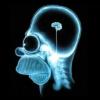Toxoplasma gondii and Schizophrenia: Linkage Through Astrocyte-Derived Kynurenic Acid?Robert Schwarcz1 and Christopher A. Hunter2 2 Department of Pathobiology, School of Veterinary Medicine, University of Pennsylvania, Philadelphia, PA 19104Keywords: infection / kynurenine / parasite
Toxoplasma gondii is a ubiquitous food- and water-borne parasite
that in most individuals is able to persist in multiple tissues,
including the central nervous system (CNS), without causing
an apparent clinical disease.
1 During the chronic phase of toxoplasmosis,
the latent stage of the parasite is found in the CNS, and studies
from murine models have established that long-term resistance
to the parasite is dependent on the ability to generate and
maintain parasite-specific CD4
+ and CD8
+ T cells. Consistent
with this observation, patients with primary or acquired defects
in T cell–mediated immunity are susceptible to toxoplasmic
encephalitis (TE). Indeed, in patients with acquired immunodeficiency
syndrome,
T. gondii is one of the most common opportunistic
infections affecting the CNS. One of the notable features that
accompanies
T. gondii infection in the CNS is a prominent activation
of resident glial cells, in particular astrocytes.
2 We propose
here that this event may play a causative role in the development
of schizophrenia.
A considerable body of evidence links
T. gondii infection to
an increased incidence of schizophrenia.
3,
4,
5,
6 However, the
association between the parasitic infection and disease, while
strong, is so far exclusively correlative in nature. Based on
epidemiological data, ie, statistical analyses, the hypothesis
has with few exceptions ignored the cellular events and molecular
mechanisms by which the infection might promote or precipitate
pathophysiology associated with schizophrenia. Recent experiments
in our laboratories have provided provocative clues regarding
the enigmatic connection between infection and disease etiology.
Our collaboration originated from the central role that astrocytes
play in the synthesis of kynurenic acid (KYNA), a metabolite
of the kynurenine pathway of tryptophan degradation. When present
at levels slightly above endogenous brain concentrations, this
metabolite can inhibit both
N-methyl-
D-aspartate (NMDA) and

7 nicotinic acetylcholine (

7nACh) receptors.
7 These two receptors
are widely purported to have causative links to cognitive processes.
Unrelated to antipsychotic medication, KYNA levels are significantly
elevated in the brain of individuals with schizophrenia.
8 Thus,
it follows that abnormally high KYNA levels may contribute to
the patients' cognitive impairment. This concept is supported
by studies in rodents, which show that experimental elevation
of cerebral KYNA levels results in impaired sensory gating.
9,
10 Furthermore, nanomolar concentrations of KYNA, by blocking presynaptic

7nACh receptors on glutamatergic nerve terminals, have been
shown to significantly reduce the extracellular levels of glutamate
in rat brain in vivo.
11,
12 KYNA may thus contribute to the putative
hyponicotinergic and hypoglutamatergic tone in schizophrenia.
13,
14In view of the proposed link between KYNA and cognitive processes,
it is important to understand the biochemical events leading
to and regulating its formation and function in the brain. KYNA
synthesis is initiated by the oxidative ring opening of tryptophan
by indoleamine 2,3-dioxygenase (IDO) and/or tryptophan dioxygenase
(TDO). The reaction product of IDO and TDO, kynurenine, is then
irreversibly converted to KYNA. In the brain, this transamination
takes place almost exclusively in astrocytes, which then rapidly
liberate newly produced KYNA into the extracellular milieu,
placing the metabolite in an excellent position to influence
surrounding neurons.
15 Interestingly, the mRNA for tryptophan
2,3-dioxygenase (TDO2) is elevated in the brain of individuals
with schizophrenia, and a concomitant increased density of TDO2-immunopositive
astroglial cells is seen in the patients' white matter.
16 Because
TDO is one of the upstream enzymes responsible for the biosynthesis
of KYNA, this enhanced expression could conceivably lead to
an elevation of KYNA levels in the diseased brain and therefore
play a part in the pathophysiology of the disorder.
As noted above, astrocyte activation is a prominent feature
of TE, but it was not known whether this reaction is associated
with a dysregulation of KYNA production. In a first attempt
to investigate this possible link, we recently examined the
brains of chronically
T. gondii–infected animals for signs
of impaired kynurenine pathway flux. Indeed, infected mice showed
massive astrocyte activation and, concomitantly, a greater than
7-fold increase in the brain content of KYNA.
17 Because this
effect was accompanied by an increase in the levels of KYNA's
bioprecursor kynurenine, these changes are likely due to a stimulation
of upstream kynurenine pathway enzymes such as IDO and/or TDO.
At present, it is unclear whether this represents a direct response
to invading parasites or, as seems more likely, a secondary
consequence of the inflammatory response that accompanies the
presence of
T. gondii in the brain.
These results show that
T. gondii infection provides an in vivo
model system to modulate a biochemical pathway associated with
schizophrenia. Jointly, the links between (1)
T. gondii and
schizophrenia; (2)
T. gondii and astrocyte activation; (3) KYNA
levels and schizophrenia; (4) KYNA synthesis and astrocytes;
(5) KYNA, NMDA, and

7nACh receptors; and (6) TDO2 and schizophrenia
suggest the following hypothetical sequence of events:
T. gondii infection, by activating astrocytes, increases KYNA formation
in the brain. This effect is augmented in persons with elevated
brain TDO activity, ie, individuals with a genetic predisposition
for schizophrenia. Increased brain KYNA levels, in turn, cause
or contribute to the excessive inhibition of glutamatergic and
nicotinergic neurotransmission, which is believed to play an
important role in the cognitive impairments seen in schizophrenia.
An interesting corollary of this hypothesis is that a reduction
in cerebral KYNA formation might benefit individuals with schizophrenia
by indirectly enhancing transmission through NMDA and

7nACh
receptors. This could be accomplished by timely interventions
that attenuate or arrest the various consequences of the parasite
infection
1 or, more specifically, by inhibitors of KYNA biosynthesis.
18 The mouse model used in our study not only provides a convenient
vehicle to test such interventions but will also allow further
mechanistic insights into the links between toxoplasmosis and
schizophrenia.














































